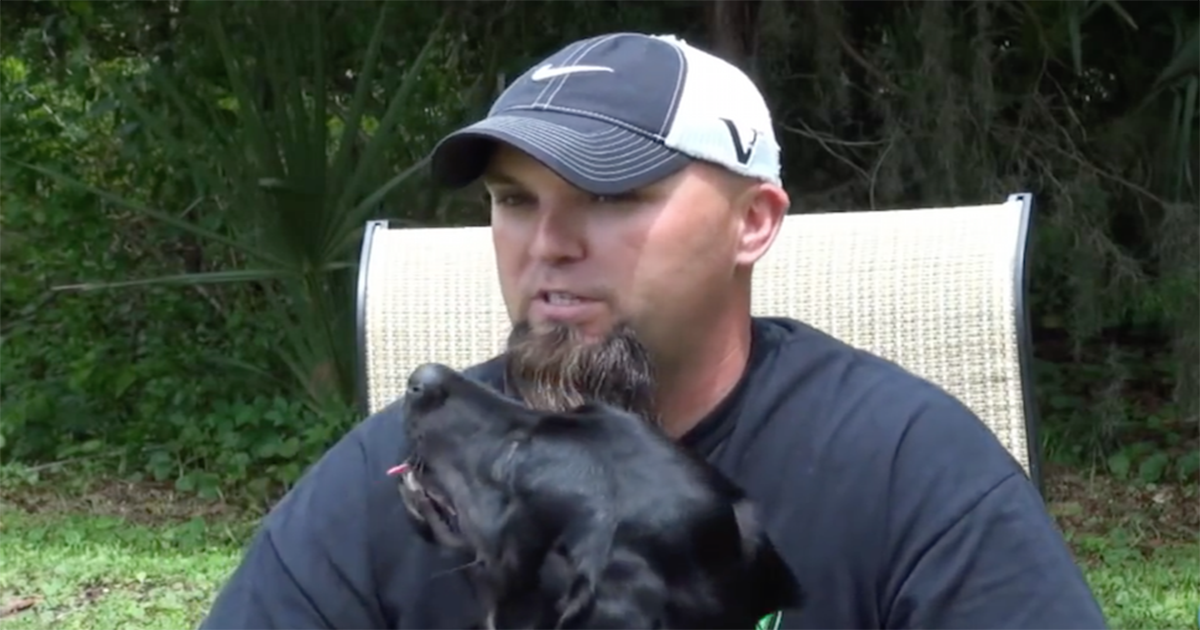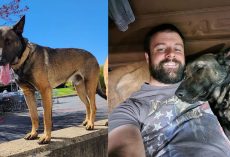Erick Scott, a veteran who served in Iraq, knows first-hand what it’s like to suffer from PTSD (Post-traumatic stress disorder – a mental health condition triggered by experiencing or seeing a terrifying event).
PTSD is also sometimes known as shell shock or combat stress, occurs after experiencing severe trauma or a life-threatening event.
For all too many veterans, it's hard to readjust to life out of the military or getting haunted by unpleasant memories and experiences. Erick was no exception.
To help him combat his anxiety, he was paired with a special service dog, Gumbo. Gumbo's main role was to notify him when he started showing symptoms of PTSD.
Watch the video on the next page to see Gumbo's amazing reaction when Scott gets agitated on camera during an interview. This is incredibly touching to see.












Sabrina Niznik
- Edit
Tracy Perkins Niznik watch this!!!
Jenifer Wyatt
- Edit
Sad but so glad he has his buddy.
Heather Pofahl
- Edit
Paul Kirk
Kristi Leclere Vicknair
- Edit
If you ever had a pain attack in your life this is truly the best medicine and a blessing. Brought tears to my eyes.
Matthew L. Crowson
- Edit
AG Polymer
Lucy Harpur
- Edit
Such a well-trained & adorable dog… WHY THE PRONG COLLAR???
Iona Rottie Mitchell
- Edit
The effect of a dog wearing a prong…..not gd
Iona Rottie Mitchell
- Edit
Yeah n I bet he don’t wear a prong collar….this poor dog is wearing one
Paul Heath
- Edit
Agreed bit, trust me, my Rottie does the same with me. She’s all over me almost before I realise how I’m feeling and she helps me through life constantly. Sad that my dog is my rock
Iona Rottie Mitchell
- Edit
That dog is wearing Spring collar….no wonder he does everything he’s told
Sandra Duffy
- Edit
What kind of collar does the dog have on? It looks like a martingale collar but has a metal link collar also. Anyone know anything about this specific collar?
Ruth Ward
- Edit
Absolutely amazing dogs really helping people , now get rid of that blasted prong collar 🙁
Tracy Jackman
- Edit
prong collars are cruel if used correctly.
Leafa Rae Humbert
- Edit
~* Some Angels have Paws… <3
Stephen Crispini
- Edit
For the amount of money we spend sending them to war we should be spending FAR more on them when they get back. It’s an unacceptable tragedy how high suicide rates are among veterans.
Kim Plotz Martin McGann
- Edit
This could be so useful for the many people who suffer PTSD…victims of abuse
Regina M. Rangel Casto
- Edit
Thanx
Deborah Howe
- Edit
Brad Traves
Clare Kellett
- Edit
Sorry still don’t agree with either of you, a prong or choke collars are wrong and cruel, I have downloaded the below to back up my claims. as a dog lover I would never use either of these collars. This is what PETA has to say on prong/choke collars.
What are the dangers of using choke and prong collars?
Choke and prong collars are designed to punish dogs for pulling by inflicting pain and discomfort. They can cause serious physical and emotional damage to dogs and should never be used.
The use of choke collars has been associated with whiplash, fainting, spinal cord injuries leading to paralysis, crushing of the trachea with partial or complete asphyxiation, crushing and/or fracture of the bones in the larynx, dislocated neck bones, bruising of the esophagus, bruising and damage to the skin and tissues in the neck, brain damage and prolapsed eyes caused by sharp increases in pressure in the head, and other injuries.
The metal spikes of prong collars pinch the skin around dogs’ necks when they pull and can scratch or puncture them. Over time, this can cause dogs to develop scar tissue (which has no feeling) and/or build up a tolerance to the painful pinching sensation and thus continue to pull, making walks even more difficult. Dogs may interpret the tightening of a choke or prong collar around their neck as a stranglehold (which it is, after all!) and become fearful or even aggressive.
The most humane and safest option for walking a dog who tends to want to pull is a front-leash attachment harness, such as the Sense-ation. When dogs lunge or pull while wearing the Sense-ation harness, the front leash attachment redirects them back toward the dogwalker. With patience and positive reinforcement, walks can be a pleasant experience for both human and dog.
Kay Boswell
- Edit
What an amazing story. X
Teresa Wur Macumber
- Edit
My daughter has a beautiful Rotti and although she doesn’t use a prong collar these dogs are amazing. Just because the prong collar is on doesn’t mean it is being used. These dogs are so smart and easy to train it is amazing
Taylor Johnson
- Edit
Pong collars are not cruel. They pinch the skin and cause discomfort that makes the dog stop whatever they are doing. They are mostly used in bite work or other guard type training. Any tool even food or a harness that is used wrong can cause harm
Timothy G Coates
- Edit
Love my labs also.
Harv Klinger
- Edit
you won’t have time to put one of those dam things on my labs cuz I’ll have my gun loaded and ready to shot!!!
Robert Thornton Kent
- Edit
Clare Kellett….you are 100% correct.
Amanda Jane
- Edit
Wtf This beautiful dog comforts its owner in his time of need yet is thought so little of that he has to wear a barbaric prong collar. This heartwarming story is ruined by such a vile instrument of torture.
David N Ann Merbach
- Edit
Support service dogs for our returned service men & women ⭐️
Lee Casey
- Edit
Zac Casey watch this.
Amiejayy Smith
- Edit
Clare Kellett your PETA is a joke
Amiejayy Smith
- Edit
Nothing wrong with those collars if used in a correct responsible way, some people are just retarded and abuse the use of those collars, not using the collar properly or responsibly is what is wrong with those collars. I use a choke chain on my dog and I have not once choked my dog
Joanna Temple Philpott
- Edit
Dogs do amazing things for us…. like shown in this video. Just incredible. BUT why do we insist on rewarding their loyalty by putting them in awful pinch/prong collars….. feel awful for this dog.
Joanna Temple Philpott
- Edit
My thoughts exactly
Jesse MacMillen
- Edit
Amy MacMillen
Wendy Wareham
- Edit
This article is about ptsd…stop taking the focus off of the veteran and the good work the dog is doing to stand on your pedestal complaining about prong collars.
Alysha Espinal
- Edit
Tina V. McDonald
Noelle Germanotta
- Edit
Watch this Linda Babich its amazing the power of a dog, and I believe Bailey has this gift.
Annette Gibb
- Edit
Great, so you use a prong collar on a dog that saves you…$#%&!@*.
Ralph Nestor
- Edit
Wow!
A.j. Jenkins
- Edit
Those are Therapy Dogs…completely different type of work. Therapy Dogs work to make other people happy and encourage healing and patient therapy. Service Dogs are task-trained to help only their owners and should not be pet/distracted by others 🙂
Joy Wingrove Costella
- Edit
Absolutely amazing.
Kayla McCullough
- Edit
Pinch collar. Because this is an incredibly strong animal and an injured vet can’t always control a large dog if it gets spooked 🙂 just trying to educate
Kayla McCullough
- Edit
It’s called a pinch or prong collar. It uses a pinching motion to notify the dog that they are pulling. If you use one, use herm spranger and Google “proper pinch collar use” because it needs to sit just under the jaw. If you can slip it over the dogs head it’s too big
Kayla McCullough
- Edit
Because this is an incredibly strong animal and an injured vet can’t always control a large dog if it gets spooked 🙂 just trying to educate
Desire Cappizi
- Edit
VERY SMART ANIMALS-HOW WONDERFUL HE HAS THE FURBABIE TO WATCH OVER HIM.
Sandra Duffy
- Edit
Thank you Kayla. I just checked it out and apparently they are banned in some states of Australia. There is a lot of debate over their use. Far too much to get into as I think there appears to be, as usual, the good and bad side.
Duane Emsley
- Edit
Nichola Blackburn
Caroline Addison
- Edit
We used to have a German Shepherd and if anyone became upset in our house he used to go up to them and nudge their arms until they stroked him and that would calm them down. He was very sensitive to our feelings and was a great comfort to us many times.
Clare Kellett
- Edit
What has banning pit Bulls to do with prong collars !!!
Elaine Haury
- Edit
what an amazing thing this beautiful freindship is, wonderful dog love this clip
Robin Jackson
- Edit
My first thoughts exactly-counter intuitive given the service these dogs are providing. Outdated training ideas. I hope they catch up b/c the service and comfort the dogs provide for ptsd is amazing!